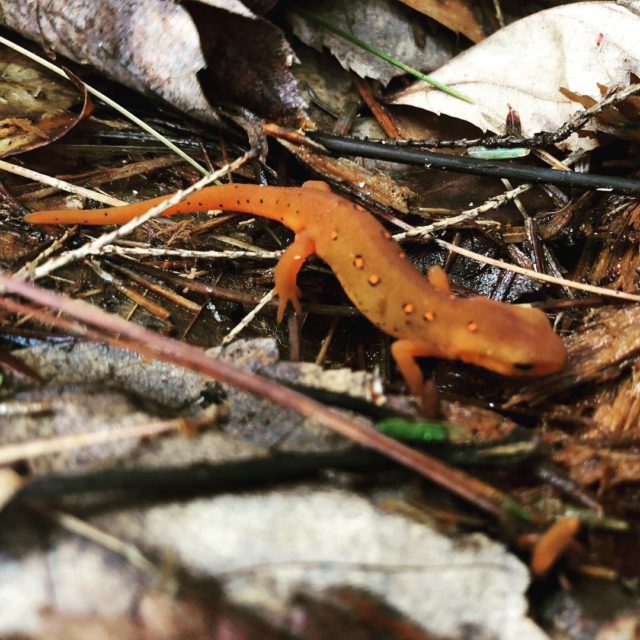By Eilís Donohue, SCA Interpretive Ranger for Franconia Notch State Park
Prime salamander spotting season has come and gone—but wait, there’s still a chance to catch a glimpse! Among enthusiasts of these lovely and delicate amphibians, the nocturnal spring migration from their hibernation spots to breeding pools is known as the Big Night. Often it lasts a few nights in the spring, but is contained within a short window of a few weeks.

Salamanders (and frogs) are nocturnal amphibians that hibernate deep beneath the forest floor over the winter. When the weather beings to warm up, they awaken and emerge from their cozy mud beds to make the trek downhill to a vernal pool, an ephemeral body of water where they prefer to lay their eggs. They need particular conditions to be able to make this journey: it must be nighttime, above freezing, and raining, so their delicate, mucus-covered skin can stay wet between destinations.

The pools and ponds of New Hampshire are home to another fascinating amphibian: the eastern red-spotted newt. Contrary to a common misconception, newts are a kind of salamander—they both belong to the family Salamandridae. Newts are of the subfamily Pleurodelinae, and are semiaquatic, meaning they spend time both in the water and on land.
There are some distinct differences between the life stages of the red-spotted newt. The eft is orange or red—a warning to predators that it is toxic—with rough skin and a round, lizard-like tail. The adult newt is yellowish or greenish brown, has slimier skin (although still not as slimy as other salamanders), and a rudder-like tail.

The juvenile form of the red-spotted newt is the red eft. The eft lives on land for one to three years, then grows gills and transforms into its aquatic adult form. Unlike many salamanders, red efts are both diurnal and nocturnal and often can be seen crawling over the leaf litter on the forest floor. For the past few weeks, I’ve seen them fairly often; their peak movement happens in May through June. They’re a sweet sight, a lovely addition to a spring hike through the woods.

The adults engage in an interesting mating ritual, which I happened to witness while at the day-use beach in Bear Brook State Park last week. Since the males and females of the species look the same, they identify each other mostly by smell; males send out pheromones into the water to signal to females. A male who has attracted a female will wrap his legs around her neck and rub his head against hers. Then he releases a sperm packet into the water, which she picks up and stores to fertilize her eggs with later. Perhaps the most interesting part of this breeding process is that the female deposits each egg individually on aquatic plants, possibly as a way to mitigate competition with other amphibian eggs. The efts often return years later to breed in the same lake, pond, or stream where they hatched.

Now that spring has fully arrived, with summer hot on its heels, it’s easier to see an abundance of aquatic wildlife. Keep your eye out for breeding and hatching newts in bodies of freshwater. If you miss this stage of this fascinating creature’s life cycle, no worries—there’s another chance to spot them in the fall, with the autumnal red eft migration. There are plenty of other creatures out and about in the warm water as well—which ones capture your fancy?

